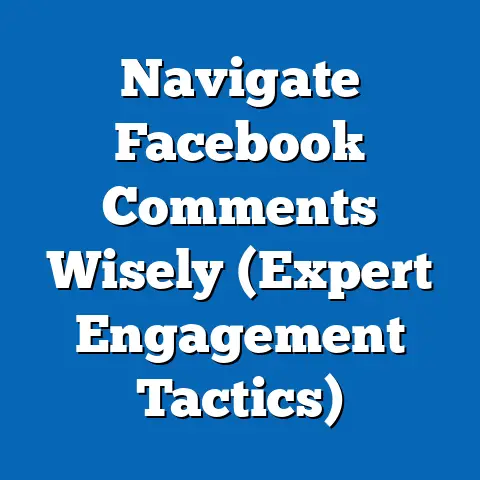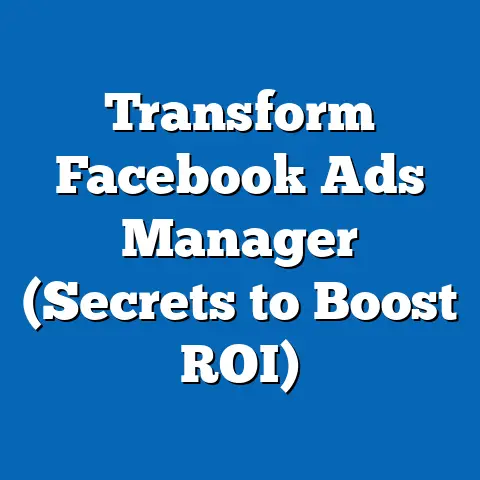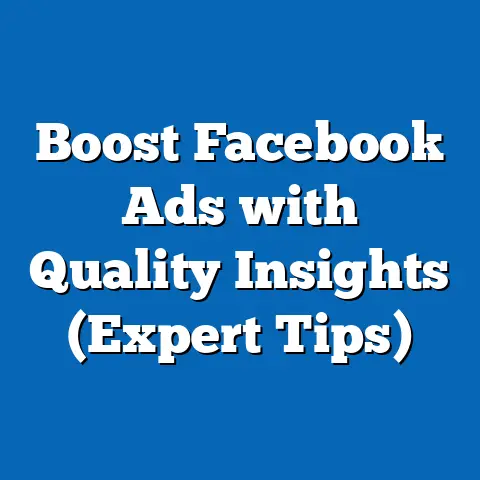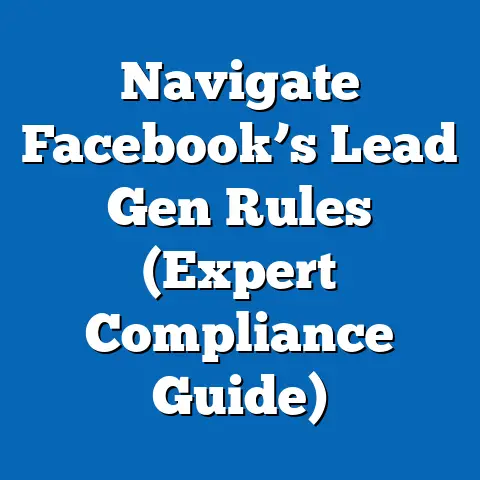Innovative fb ad Strategies for Dropshipping Success (Game-Changer)
The world of e-commerce has exploded in recent years, with dropshipping emerging as a low-barrier entry point for aspiring entrepreneurs. One of the most powerful tools for driving success in this space is Facebook (FB) advertising, which offers unparalleled customizability to target niche audiences with precision. As of 2023, Meta reports that Facebook has over 2.9 billion monthly active users, making it a goldmine for businesses looking to scale through tailored ad campaigns (Meta Investor Relations, 2023).
Dropshipping, a retail model where sellers market products without holding inventory, relies heavily on effective advertising to convert clicks into sales. According to a 2022 report by Statista, the global dropshipping market was valued at $128 billion in 2021 and is projected to reach $476.1 billion by 2026, growing at a compound annual growth rate (CAGR) of 28.8%. This rapid growth underscores the need for innovative strategies to stand out in a crowded digital marketplace.
Demographically, dropshipping businesses often target younger audiences, with 18-34-year-olds making up a significant portion of online shoppers. A 2023 survey by eMarketer found that 67% of Gen Z and 58% of Millennials have made impulse purchases through social media ads, highlighting the potential of platforms like Facebook for dropshipping success. In this article, we’ll explore game-changing Facebook ad strategies tailored for dropshipping, supported by data, trends, and actionable insights to help entrepreneurs maximize returns.
Why Facebook Ads Are a Game-Changer for Dropshipping
Facebook’s advertising platform stands out due to its robust targeting options, allowing dropshippers to reach specific demographics based on interests, behaviors, and location. With over 200 million businesses using Facebook’s tools for advertising (Meta Business, 2023), the platform offers a competitive yet fertile ground for dropshipping ventures. The ability to customize ads—whether through visuals, copy, or audience segmentation—makes it a cornerstone for driving traffic and conversions.
Moreover, Facebook ads are cost-effective compared to other channels. According to WordStream’s 2023 data, the average cost-per-click (CPC) for Facebook ads across industries is $1.72, significantly lower than Google Ads’ average CPC of $2.69. For dropshippers operating on tight budgets, this affordability can be a game-changer when paired with high-converting strategies.
Historically, dropshipping relied on broad, untargeted ads in the early 2010s, often yielding low returns. Today, with advancements in machine learning and Facebook’s algorithm updates, advertisers can leverage data-driven insights to optimize campaigns in real-time. This evolution has transformed FB ads into a precision tool for dropshipping success.
Key Trends Shaping Facebook Advertising for Dropshipping in 2023
Before diving into specific strategies, it’s essential to understand the broader trends influencing Facebook advertising. First, video content continues to dominate engagement rates. A 2023 report by Social Insider revealed that video ads on Facebook achieve an average engagement rate of 6.01%, compared to 3.85% for image-based ads.
Second, personalization is no longer optional—it’s expected. According to a 2022 study by McKinsey, 71% of consumers expect personalized interactions from brands, and 76% get frustrated when this expectation isn’t met. For dropshippers, this means tailoring ad creatives and messaging to resonate with niche audiences.
Lastly, the rise of mobile-first shopping cannot be ignored. Statista reports that 73% of global e-commerce sales in 2023 are expected to occur via mobile devices. This trend emphasizes the need for mobile-optimized ads that load quickly and display effectively on smaller screens—a critical factor for dropshipping campaigns targeting impulse buyers.
Innovative FB Ad Strategies for Dropshipping Success
1. Hyper-Targeted Audience Segmentation
One of the most powerful features of Facebook ads is the ability to segment audiences with laser precision. Dropshippers can target users based on demographics, interests, purchase behaviors, and even life events. For instance, targeting “engaged individuals” for wedding-related products or “new parents” for baby gear can yield higher conversion rates.
According to a 2022 case study by Shopify, dropshipping stores that used hyper-targeted ads saw a 30% increase in return on ad spend (ROAS) compared to those using broad targeting. To implement this, start by creating custom audiences from website visitors or past purchasers using Facebook Pixel data. Then, build lookalike audiences to reach similar users, expanding your reach without sacrificing relevance.
Demographically, consider the purchasing power and preferences of your audience. For example, eMarketer data shows that women aged 25-34 are more likely to engage with fashion and beauty ads (engagement rate of 5.2%), while men aged 18-24 show higher interaction with tech gadgets (engagement rate of 4.8%). Tailoring your targeting to these patterns can significantly boost campaign performance.
Data Visualization Description: Imagine a pie chart showing audience segmentation by age and gender for a dropshipping store selling fitness gear, with 40% of engagement from men aged 18-24, 30% from women aged 25-34, and the remaining split across other demographics. This visual would highlight the importance of focusing ad spend on high-engagement groups.
2. Dynamic Product Ads for Personalized Retargeting
Dynamic Product Ads (DPAs) are a game-changer for dropshipping, as they automatically showcase products to users based on their browsing history. This strategy is particularly effective for retargeting users who visited your store but didn’t complete a purchase. According to Meta, DPAs can increase click-through rates (CTR) by up to 34% compared to static ads (Meta Advertising Insights, 2023).
To set up DPAs, integrate your product catalog with Facebook’s Business Manager and use the Pixel to track user behavior. For example, if a user viewed a specific pair of sneakers on your site, the DPA will display that exact product in their feed, often with a discount or urgency-driven call-to-action (CTA). This personalization taps into the consumer desire for relevant content, as evidenced by McKinsey’s findings on personalization expectations.
Historically, retargeting was less effective due to limited tracking capabilities. However, with today’s tools, dropshippers can achieve conversion rates of 10-15% on retargeting campaigns, compared to 1-2% for cold audiences (AdRoll, 2023). This stark difference highlights why DPAs should be a cornerstone of any dropshipping ad strategy.
3. Leveraging User-Generated Content (UGC) in Ad Creatives
Authenticity resonates with today’s consumers, and user-generated content (UGC) is a powerful way to build trust. UGC includes customer reviews, photos, or videos showcasing your products in real-life settings. A 2023 survey by Stackla found that 79% of consumers say UGC highly impacts their purchasing decisions, compared to only 8% for influencer content.
For dropshippers, incorporating UGC into Facebook ads can be as simple as featuring customer testimonials or reposting user photos (with permission). This approach not only reduces content creation costs but also boosts credibility. A case study by Oberlo in 2022 showed that dropshipping stores using UGC in ads saw a 25% higher CTR compared to polished, brand-created content.
Demographically, UGC tends to resonate more with younger audiences. Gen Z, for instance, values authenticity over perfection, with 63% trusting peer recommendations over traditional ads (Morning Consult, 2023). Tailor your UGC strategy to appeal to this demographic by highlighting relatable, unfiltered content in your campaigns.
4. Testing and Optimizing with A/B Split Testing
A/B testing, or split testing, is a critical strategy for identifying what works in your Facebook ad campaigns. By testing variables like ad copy, visuals, CTAs, or audience segments, dropshippers can refine their approach based on data-driven insights. According to HubSpot’s 2023 Marketing Report, businesses that regularly A/B test their ads see a 20-30% improvement in conversion rates over time.
Start by creating two versions of an ad with a single variable changed—for example, one with a “Shop Now” CTA and another with “Get 20% Off.” Run both ads simultaneously with a small budget (e.g., $10 per day) and analyze metrics like CTR, CPC, and ROAS after 48-72 hours. Facebook’s Ads Manager provides detailed breakdowns of performance, making it easy to scale the winning variant.
Historically, many dropshippers relied on guesswork for ad creation, leading to wasted budgets. Today, with accessible testing tools, even small-scale entrepreneurs can optimize campaigns effectively. For instance, a 2022 experiment by a dropshipping store selling pet products found that ads with emotional storytelling copy outperformed generic sales copy by 40% in terms of engagement (Shopify Blog, 2022).
Data Visualization Description: Picture a bar graph comparing the CTR of two ad variants over a week, with Variant A (emotional copy) at 3.5% and Variant B (sales copy) at 2.1%. This visual would underscore the impact of testing on campaign success.
5. Utilizing Video Ads for Higher Engagement
As mentioned earlier, video content reigns supreme on Facebook, offering dropshippers an opportunity to capture attention quickly. Short, engaging videos (15-30 seconds) that highlight product benefits or demonstrate usage can significantly boost engagement. Social Insider’s 2023 data confirms that video ads not only have higher engagement rates but also a 12% lower CPC compared to static ads.
For dropshipping, consider creating product unboxing videos, “before and after” transformations, or customer testimonials in video format. Tools like Canva or InVideo make it easy to produce professional-looking content without a large budget. Additionally, ensure videos are mobile-optimized with captions, as 85% of Facebook users watch videos without sound (Digiday, 2023).
Demographically, video ads appeal strongly to younger audiences, with 72% of Gen Z and 65% of Millennials engaging with video content on social platforms (eMarketer, 2023). Tailor your video messaging to these groups by incorporating trending music, memes, or challenges to increase shareability and reach.
6. Capitalizing on Seasonal and Urgency-Driven Campaigns
Timing is everything in dropshipping, and Facebook ads can be leveraged to create urgency around seasonal events or limited-time offers. Campaigns tied to holidays like Black Friday or Valentine’s Day often see spikes in conversions due to heightened consumer spending. According to the National Retail Federation (NRF), U.S. holiday sales in 2022 reached $936.3 billion, with 43% of purchases influenced by online ads.
Create ads with countdown timers, flash sale announcements, or phrases like “Only 24 Hours Left!” to drive immediate action. A 2023 study by AdEspresso found that urgency-driven ads increase CTR by 22% compared to standard promotions. Pair this with retargeting to remind past visitors of time-sensitive deals, maximizing conversion potential.
Historically, seasonal campaigns were less data-driven, often missing key audience insights. Today, dropshippers can use Facebook’s historical data and Audience Insights to predict peak shopping times and tailor ads accordingly. For example, targeting parents with back-to-school deals in late August can yield a 15-20% higher ROAS compared to off-season campaigns (Facebook Business Case Studies, 2023).
Challenges and Pitfalls to Avoid in FB Ads for Dropshipping
While Facebook ads offer immense potential, dropshippers must navigate challenges to ensure success. First, ad fatigue—when audiences see the same ad too often—can lead to declining engagement. A 2022 report by Hootsuite found that ad fatigue sets in after 3-5 exposures, reducing CTR by up to 50%.
To combat this, regularly refresh ad creatives and rotate audiences. Additionally, avoid overpromising in ads, as this can lead to high return rates and negative feedback. Transparency about shipping times (a common pain point in dropshipping) is crucial, especially since 54% of online shoppers abandon carts due to unexpected delays (Baymard Institute, 2023).
Lastly, compliance with Facebook’s ad policies is non-negotiable. Violations—such as misleading claims or prohibited products—can result in account suspension. Always review Meta’s Advertising Standards before launching campaigns to avoid costly disruptions.
Broader Implications and Future Trends for Dropshipping Ads
The strategies outlined above demonstrate how innovative Facebook ad approaches can transform dropshipping businesses into scalable ventures. As the global dropshipping market continues to grow toward a projected $476.1 billion by 2026 (Statista, 2022), competition will intensify, making data-driven advertising more critical than ever. Dropshippers who master hyper-targeting, personalization, and video content will likely maintain a competitive edge.
Demographically, as Gen Z’s purchasing power grows—projected to account for 27% of global income by 2030 (Bloomberg, 2023)—dropshippers must adapt to their preferences for authenticity, sustainability, and mobile-first experiences. Staying ahead of these trends will be key to long-term success in the evolving landscape of social media advertising.
In conclusion, Facebook ads remain a game-changer for dropshipping, offering customizable, cost-effective solutions to reach vast audiences. By leveraging the strategies discussed—hyper-targeting, dynamic ads, UGC, A/B testing, video content, and urgency-driven campaigns—entrepreneurs can unlock unprecedented growth. The future of dropshipping lies in continuous adaptation, driven by data and innovation, ensuring that those who invest in cutting-edge ad tactics will thrive in this dynamic market.






